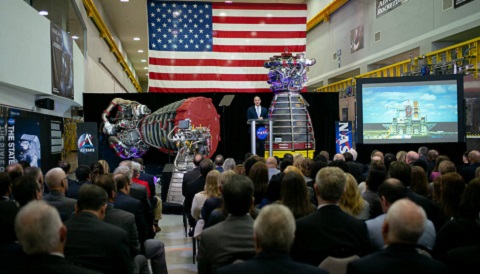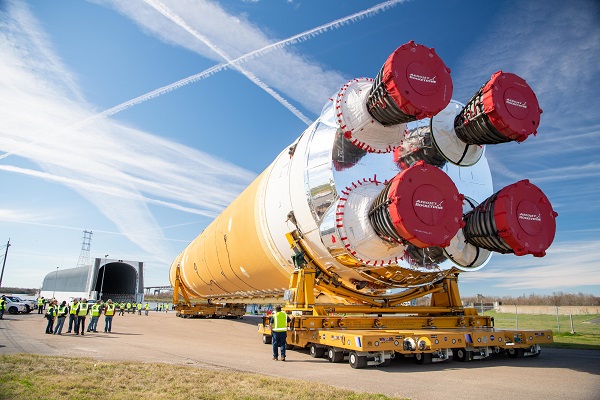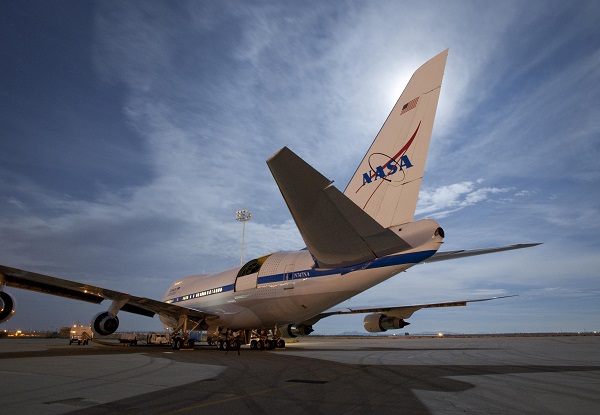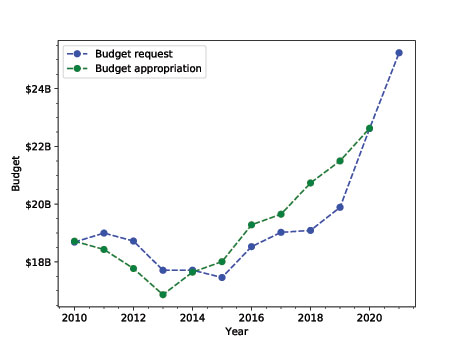What’s in the New Proposed NASA Budget – Sky & Telescope
The latest 2021 budget request for NASA would push hard for human lunar exploration at the cost of several key programs.

NASA Administrator Jim Bridenstine discusses the 2021 budget proposal during a State of NASA address on February 10th at Aerojet Rocketdyne’s facility at NASA’s Stennis Space Center.
NASA / Joel Kowsky
What’s in store for space exploration in the coming year? The current administration recently released its request for the U.S. budget for fiscal year 2021, including the proposal for NASA. Of course, this is just a proposal and will pass through several iterations before it becomes reality.
The proposal comes at a time when the Artemis initiative to return humans to the Moon is just getting underway. Meanwhile, the Mars 2020 rover, which is slated to launch this summer, will land on the Red Planet in February 2021. And both the long-awaited James Webb Space Telescope and the Space Launch Services (SLS) rocket should also reach the launch pad in 2021.
The FY NASA 2021 budget proposal would see the space agency receiving $25.5 billion overall, just over 0.5% of the total proposed government budget, which tops out at a record $4.8 trillion. Although this is a 12% increase from 2020, a majority of the increases go toward the Artemis initiative, which includes a crewed landing on the Moon by the end of 2024.

An SLS rocket stage is about to be loaded on the Pegasus barge for shipment.
NASA Stennis Space Center
“We are preparing to achieve pivotal milestones this year in development of the Space Launch System rocket, Orion spacecraft, and the (Lunar) Gateway,” says Jim Bridenstine (NASA-Administrator) in a recent press release. “They constitute our ability to build a sustainable lunar presence and eventually send human missions to Mars.”
Under the new proposal, several projects are zeroed out, including the Wide-Field Infrared Survey Telescope (WFIRST) and the flying Stratospheric Observatory for Infrared Astronomy (SOFIA). The proposed cancellation of WFIRST is a bit of a sucker punch to the astronomy community, which singled out this mission as a top priority in the 2010 decadal survey. SOFIA’s proposed cancellation would also fly in the face of recent and upcoming improvements to this unique airborne observatory.
Of course, this isn’t the first time these two missions have faced the budgetary ax. WFIRST’s budget has been zeroed out for the past two years running, and SOFIA has faced cancellation many times — yet both have survived to this point thanks to congressional intervention. The Office of STEM Engagement would also be terminated under the current proposal, as has been requested in previous years as well.

The SOFIA flying observatory
NASA Ames
Two Earth science missions have faced termination before, too: Climate Absolute Radiance and Refractivity Observatory Pathfinder and the Plankton, Aerosol, Cloud and ocean Ecosystem observatory. The current budget request would also suspend NASA’s Near-Earth Object Surveillance Mission, which would hunt for potentially hazardous asteroids.
Funding for the James Webb Space Telescope would drop slightly (by 2%) to $414.7 million. A majority of those gains would go to human exploration, including the Lunar Gateway, which will orbit the Moon, and the development of a lander, which will take astronauts to the surface. The SLS rocket, which will take astronauts from Earth to the Moon, also lost a bit; it’s down 13% to $2.257 billion.
Under this proposal, NASA’s 2021 budget would defer designing a more powerful second stage Block 1b variant of the SLS rocket in favor of finishing the Block 1a model needed for upcoming crewed Moon missions. This would have repercussions down the line. The Europa Clipper, for example, was to launch on an upgraded SLS rocket in 2025, but the proposal would move Europa Clipper to a commercial carrier to save $1.5 billion. Though unnamed, the only commercial heavy lift rocket currently available would be SpaceX’s Falcon Heavy.
The first uncrewed SLS launch is set for 2021, with the first crewed mission performing a lunar flyby sometime in 2022.
Mars missions fare well under the proposal, mostly as precursors to human missions in the 2030s. A Mars Sample Return mission will follow this summer’s launch of the soon-to-be-named rover, and the Mars Ice Mapper mission will eventually head to the Red Planet, too, tentatively in 2027.
Of course, at this point, the proposal is just that: final budgets rarely resemble first drafts once they’ve navigated Congress.

This plot shows both NASA’s total congressional appropriation in billions of dollars and the amount requested by the President. The horizontal axis is fiscal years. This data is based off of the Planetary Society’s collection of NASA’s full budget history.
The House of Representatives recently released H.R. Bill 5666 in January, giving guidance for possible future funding for NASA, but without a single mention of the Artemis initiative. Instead, the bill mentions a quick ‘flags and footprints’ style lunar mission in 2028 as a stepping stone to sending humans to Mars in 2033.
However, the President made brief mention of Artemis and the new Space Force branch of the military during his State of the Union address, suggesting that the President and Congress are probably at odds when it comes to the future direction of human space exploration. The political winds may well shift again this election year.
Space may be hard, but funding it — especially with a long term objective — is even harder.






